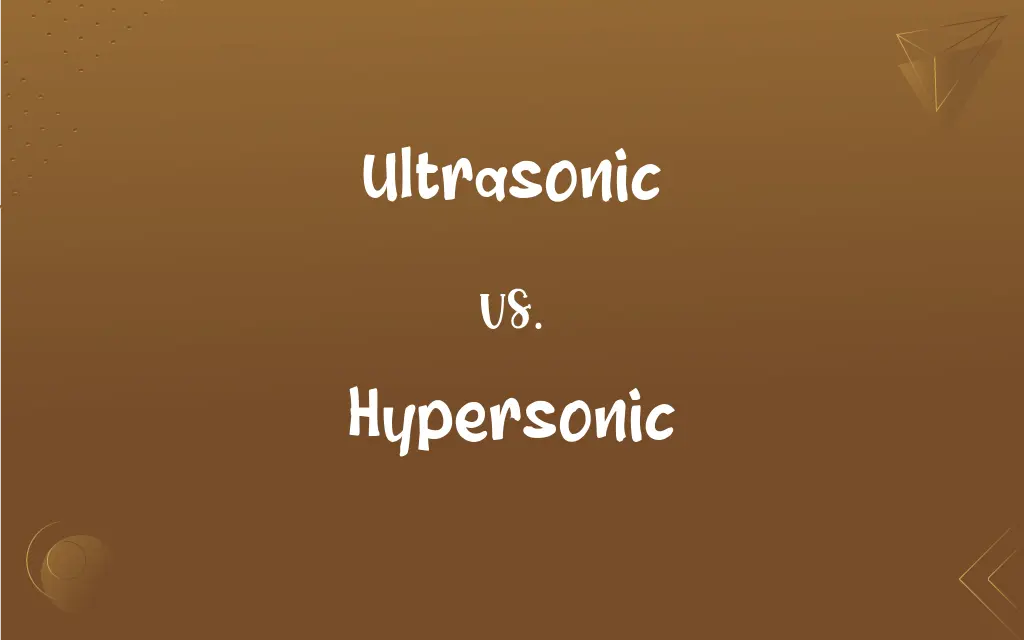Ultrasonic vs. Hypersonic: What's the Difference?
Edited by Harlon Moss || By Janet White || Published on November 22, 2023
Ultrasonic refers to sound frequencies above the range of human hearing, while hypersonic pertains to speeds exceeding five times the speed of sound.

Key Differences
Ultrasonic and hypersonic represent two distinct realms within physics. While ultrasonic is related to sound and its frequency, specifically those beyond the human range of hearing, hypersonic concerns itself with speeds, specifically those that are five or more times faster than the speed of sound.
In the realm of acoustics, ultrasonic frequencies are those that exceed the human hearing range, typically above 20 kHz. These frequencies are utilized in various technologies such as medical imaging and sonar. On the other hand, hypersonic refers to aerodynamic speeds and is often used in aerospace contexts, denoting velocities that are multiples of the speed of sound.
An ultrasonic wave can travel through various mediums, including air, water, and solid materials, often used in applications like cleaning delicate items or detecting flaws in metals. Meanwhile, hypersonic speeds, which start from Mach 5, represent challenges for engineers, especially in the design of aircraft, due to the immense heat and pressure at such velocities.
It's important to understand that while ultrasonic describes a kind of sound wave that cannot be heard by humans, hypersonic describes an object or phenomenon moving at extreme speeds. The former is about frequency, and the latter is about velocity.
Lastly, both ultrasonic and hypersonic technologies have immense potential and importance. Ultrasonic technology plays a crucial role in medical diagnostics, whereas hypersonic capabilities could revolutionize air travel and missile technology.
ADVERTISEMENT
Comparison Chart
Definition
Refers to sound frequencies above human hearing range.
Pertains to speeds greater than five times the speed of sound.
Context
Acoustics
Aerodynamics
Measurement
Frequency (typically above 20 kHz)
Speed (starting from Mach 5)
Applications
Medical imaging, cleaning, sonar.
Aerospace, missile technology.
Nature
Concerned with sound.
Concerned with motion.
ADVERTISEMENT
Ultrasonic and Hypersonic Definitions
Ultrasonic
Relating to sound waves with a frequency above the limit of human hearing.
Ultrasonic devices are used in medical imaging.
Hypersonic
Relating to speeds of more than five times the speed of sound.
Hypersonic missiles pose new challenges for defense systems.
Ultrasonic
Of or pertaining to ultrasonography.
The ultrasonic scan revealed the baby's gender.
Hypersonic
Extremely fast or rapid.
The hypersonic changes in technology have transformed our lives.
Ultrasonic
Operating or functioning using ultrasonic waves.
Ultrasonic sensors can detect even small movements.
Hypersonic
Of or relating to velocities greatly exceeding the speed of sound.
The hypersonic glide vehicle can maneuver while maintaining speed.
Ultrasonic
Beyond the range of audible sound.
Bats use ultrasonic calls for echolocation.
Hypersonic
Of, relating to, or achieving speeds beyond the speed of sound many times over.
The hypersonic jet aims to reduce travel time between continents.
Ultrasonic
Utilizing, produced by, or involving ultrasonic waves.
The ultrasonic cleaner efficiently removed the dirt.
Hypersonic
Pertaining to phenomena, objects, or motions that move at hypersonic speeds.
Hypersonic flight requires advanced materials to withstand heat.
Ultrasonic
Of or relating to acoustic frequencies above the range audible to the human ear, or above approximately 20,000 hertz.
Hypersonic
Of, relating to, or capable of speed equal to or exceeding five times the speed of sound.
Ultrasonic
Of, relating to, or involving ultrasound.
Hypersonic
Equal to, or greater than, or capable of achieving, five times the speed of sound.
Ultrasonic
(acoustics) Beyond (higher in frequency than) the range of sound perceptible to the human ear; with a frequency of 20 kilohertz or higher.
Hypersonic
Far enough above the speed of sound as to cause significant differences in behaviour due to chemical reactions or dissociation of the air.
Ultrasonic
Having frequencies above those of audible sound
Hypersonic
Pertaining to or moving at a speed greatly in excess of the speed of sound, usually meaning greater than mach 5. All speeds in excess of the speed of sound are supersonic, but to be hypersonic requires even higher speed.
FAQs
Can humans hear ultrasonic sounds?
No, ultrasonic sounds are above the frequency range of human hearing.
Are hypersonic speeds achievable for commercial aircraft?
Currently, hypersonic speeds are a challenge for commercial travel, but research is ongoing.
How do bats utilize ultrasonic frequencies?
Bats emit ultrasonic calls for echolocation to navigate and hunt.
What's the frequency range for ultrasonic waves?
Ultrasonic waves typically range from 20 kHz to several gigahertz.
Why are hypersonic missiles considered game-changers?
Hypersonic missiles can travel extremely fast, making them hard to detect and intercept.
Is ultrasonic cleaning efficient?
Yes, ultrasonic cleaning can be very efficient at removing minute particles.
Do ultrasonic pest repellents work?
Ultrasonic pest repellents have mixed reviews, and their effectiveness varies.
What's the starting speed for hypersonic?
Hypersonic speeds start from Mach 5.
Is the heat a concern for hypersonic aircraft?
Yes, hypersonic speeds generate immense heat, requiring advanced materials and cooling systems.
Are there materials that can withstand hypersonic heat?
Advanced materials, like certain ceramics, are being developed to withstand hypersonic heat.
Do ultrasonic waves have applications in medicine?
Yes, ultrasonic waves are used in medical sonography or ultrasounds.
Are ultrasonic waves used in underwater communication?
Yes, underwater sonar and communication often utilize ultrasonic frequencies.
Are there any hypersonic commercial flights?
As of now, hypersonic commercial flights aren't available, but research into their feasibility is ongoing.
Can hypersonic speeds be achieved in outer space?
In space, the concept of Mach numbers doesn't apply as there's no air, but spacecraft can achieve speeds far exceeding Mach 5.
Is ultrasonography based on ultrasonic waves?
Yes, ultrasonography utilizes ultrasonic waves to produce images.
Is hypersonic technology used in space exploration?
While the term "hypersonic" is terrestrial, technologies used for achieving high speeds in space may benefit from hypersonic research.
Are ultrasonic waves harmful?
Generally, ultrasonic waves are safe, but at very high intensities, they could be harmful.
How does hypersonic speed compare to supersonic speed?
Hypersonic speed exceeds Mach 5, while supersonic speed ranges between Mach 1 and Mach 5.
What industries use ultrasonic cleaning?
Industries like jewelry, electronics, and healthcare often use ultrasonic cleaning.
How fast is hypersonic speed in miles per hour (mph)?
Hypersonic speed starts at Mach 5, which is roughly 3,806 mph at sea level.
About Author
Written by
Janet WhiteJanet White has been an esteemed writer and blogger for Difference Wiki. Holding a Master's degree in Science and Medical Journalism from the prestigious Boston University, she has consistently demonstrated her expertise and passion for her field. When she's not immersed in her work, Janet relishes her time exercising, delving into a good book, and cherishing moments with friends and family.
Edited by
Harlon MossHarlon is a seasoned quality moderator and accomplished content writer for Difference Wiki. An alumnus of the prestigious University of California, he earned his degree in Computer Science. Leveraging his academic background, Harlon brings a meticulous and informed perspective to his work, ensuring content accuracy and excellence.






































































